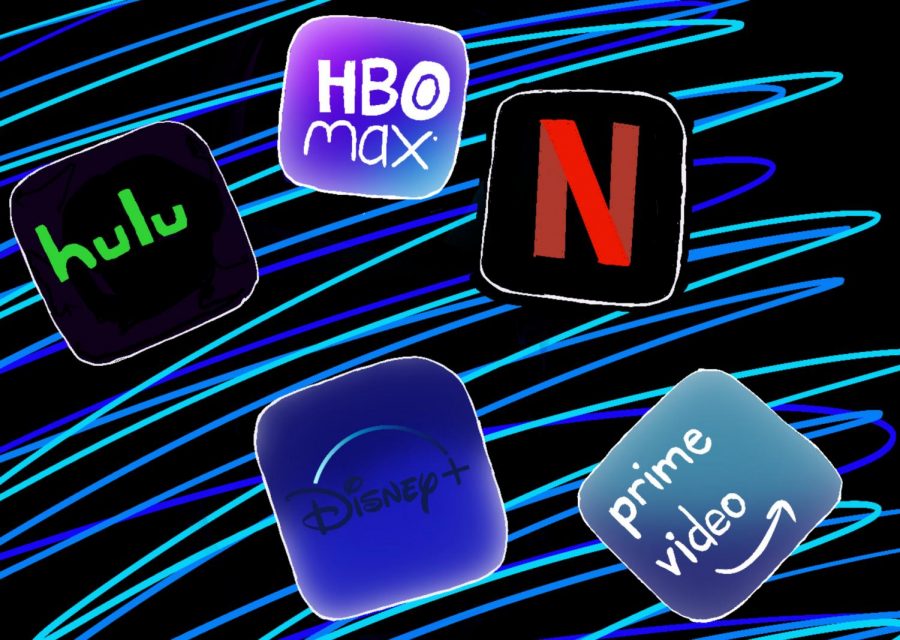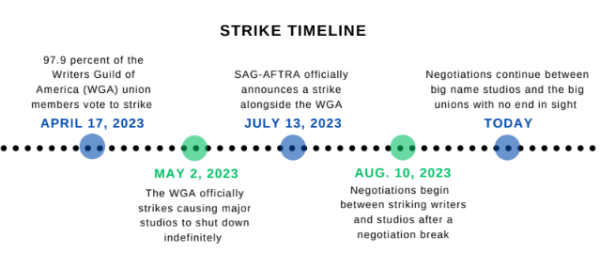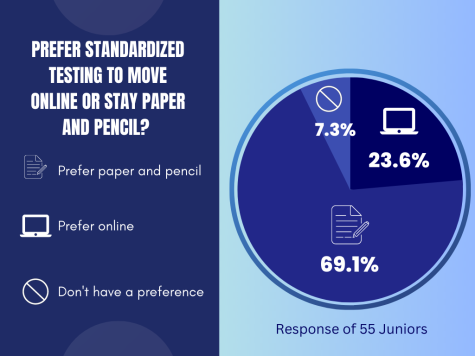The Entertainment of the Future: Streaming Services
People are increasingly shifting from watching live entertainment and cable to on-demand streaming options.
The entertainment industry isn’t static; it changes with the times based on new technology and social circumstances. Before the 20th century, the entertainment industry consisted solely of live performances, like those at theaters or circuses. In the early 20th century, TVs and movie theaters were invented and around the 1950s, they slowly began to overtake live, in-person shows as the most prominent way people were entertained in their leisure time.
In the first two decades of this century, a challenge to the dominance of these media was introduced: streaming services. In the past few years, there has been a slow decline in the prominence of cable TV and movie theaters due to streaming platforms, like Netflix, releasing their own TV shows and movies that people can watch on their phones, tablets or laptops, whenever they want.
This trend sped up dramatically with the outbreak of the COVID-19 pandemic. With stay-at-home orders in place, people could not go to the movie theater. The pandemic also halted the filming of weekly cable TV shows and cable’s biggest draw, live sports, had their seasons put on hold.
So, the American people turned to streaming services and their libraries of thousands of shows and movies readily available. Netflix was the first of these platforms, and is still the most prominent. Although, in the last few years, other streaming services such as HBO Max, Disney+, Amazon Prime Video, and Hulu have risen as challengers. Once the pandemic has passed, will people go back to theaters and live TV? Or will the big and small screens see the same fate as plays and circuses did 70 years ago?
Cutting the Cord
The decline in ratings for shows on cable TV has been substantial in the last half decade. The Leichtman Research Group has done studies on these trends for many years, and the data they are finding proves that many U.S. households are cutting the cord on cable TV.
According to the 2019 Leichtman study, the amount of viewers for the top show on the CBS weekly schedule dropped from 17.4 million viewers in 2014 to 10.8 million viewers in 2018. They’ve also found out that since 2015, the percentage of households with a streaming service has risen from 52% to 78%. In that same time period, homes with cable have dropped from 84% to 78%.
One man who has cut the cord is philosophy and film teacher Craig Schmidt. He made his decision because “cable was just getting more and more expensive, and we were watching a lot of things on Netflix and Amazon Prime anyway. And then we found out Hulu at the time was 11 or 12 bucks, and it carried most of the major networks.”
A combination of Hulu as well as the streaming services Mr. Schmidt subscribes to (Netflix, Disney+, HBO Max and Apple TV), has made him “not miss anything.” However, he does recognize a few things keeping cable afloat.
“I know that my buddies do watch a lot more live sports than I do, so they don’t want to get rid of cable,” he said. Mr. Schmidt also realizes that live news networks are important to many people, but he believes that “with the internet, it’s not like I’m disconnected from what’s going on.” Twenty percent of households have only streaming services, like Mr. Schmidt, compared to just 16% that have only cable. The majority of households (58%) have cable and subscribe to at least one streaming service, according to Liechtman.
Freshman Sofija Tijunelis’s family falls into the majority. Her family subscribes to Netflix, Disney+, Hulu and Amazon Prime, but has not cut the cord on cable. Despite this, Tijunelis herself spends much more of her time watching streaming services.
“[On cable], I watch sports, like football, with my dad and my family a lot. But other than that, not really,” she said.
Tijunelis had popular reasons for why she prefers these new platforms: “With the streaming services, you can choose whatever you want to watch and there are no commercial breaks. They kind of draw my attention away from the TV.”
Tijunelis also said she thinks Netflix is the best of these platforms because it has “shows for everyone of all ages.” Whether it is the best or not, Netflix is the most popular. It had the highest percentage of streaming activity in the 3rd quarter of 2020 at 25%, according to Reelgood, a service that tracks which movies are available on which streaming platform. However, it was followed closely by Amazon Prime at 21%. The list was rounded out with Hulu at 15%, HBO Max at 9% and Disney+ at 6%.
The Streaming Services
Despite each of these services offering movies and TV shows, they have each tried to diversify and distinguish themselves. Netflix was the original streaming service, featuring thousands of movies from a variety of production companies. However, with the rise of competition, it began to diminish this overall content in favor of original content. Along with thousands of shows, a Netflix-original movie will be released on the platform every week in 2021. These movies feature A-list actors such as Dwayne “The Rock” Johnson, Chris Hemsworth, Zendaya, Meryl Streep and Leonardo DiCaprio.
Amazon Prime has picked up where Netflix has dropped out in the total content game. They have over 13,000 films available, which is more than triple the amount of total content Netflix has.
Disney+ is all Disney, which includes Marvel and Star Wars. At Disney’s Investor Day in December, they announced a lineup of 43 original TV shows that will be set within the Marvel Universe, Star Wars Universe or the World of Pixar. Disney+ also features thousands of movies made by Disney and shows from the Disney Channel.
Hulu has found its niche in the market by offering shows that are available to stream while also having live channels. Their catchphrase on advertisements, “Hulu has live sports,” potentially draws in those who only keep cable due to live sports.
The Future of Movies
All of these streaming services are proving to be a substantial challenge to not just cable TV but also to movie theaters. The pandemic resulted in an understandable and significant downturn in movie theater attendance, and now the question is: will people return to the theaters? And if so, when will they feel comfortable doing so?
Some filmmaking companies sure don’t think this return will happen anytime soon. Warner Bros. recently struck a deal to release their entire 2021 slate of 17 films on HBO Max on the same day the films are released in theaters. The stock shares of the two largest theater chains — AMC and Cinemark — dropped 16% and 22%, respectively, with the announcement of this news.
“Movie theaters are furious about [the Warner Bros. decision} and they’re saying that’s going to be the end of movie theaters as we know it, which might be true,” Mr. Schmidt said.
However, it’s not like movie theaters are going away just yet. People now will have a choice. It remains to be seen if they will go to the theaters when they have the option to watch the same content from home on a streaming service.
“The movie theater has a different kind of experience to it with surround sound and popcorn. I definitely miss that feeling a lot, but it is pretty expensive, so I guess it’d be debatable [if I’d go],” Tijunelis said.
Mr. Schmidt added, “Covid has just sort of accelerated where things were gonna go as far as within the industry,” he said. “If you’re just watching a drama or a romantic comedy, that stuff will probably go to one of these streaming services. People have said that the thing that will get people back into movie theaters will be the huge action movies like Marvel movies and Star Wars. Disney will come in and save the day.”
When asked if he would return to the theater if the movie was also available on a streaming service, Mr. Schmidt said it would “absolutely depend on the film.”
So, it will be up to the people if cable TV and movie theaters stay around. If people want these forms of entertainment to stay relevant, they will watch them and pay for them. If they don’t, cable TV and movie theaters could see the same fate as plays and circuses.





![Senior Sam Foster, who plays the alto saxophone on the Jazz Lab Band, waves at the audience after their final piece. “[Jazz is] just something that I enjoy personally, and I wanted to do,” Foster said.](https://www.lhsdoi.com/wp-content/uploads/2024/04/USE4-600x400.jpg)


![For the final piece, a combination of Symphony Orchestra and Wind Ensemble played an extravagant song by Paul Hindemist. Flute soloist Dakota Olson had her moment highlighted within this song. “[My solo] was definitely challenging but it was fun too,” Olson said.](https://www.lhsdoi.com/wp-content/uploads/2024/03/amy-and-joey-shot-600x400.jpg)





![The Bel Canto choir, the junior choir, performs “Ex-Wives” from “SIX.” “We started [preparing], pretty much right after the Holiday concert,” junior Delaney Rybicki said. Caption by Ash Magalhaes](https://www.lhsdoi.com/wp-content/uploads/2024/02/IMG_7696-600x400.jpg)




